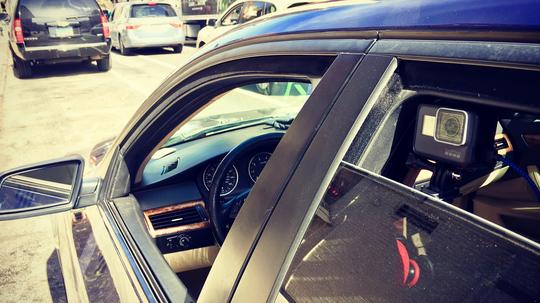
As it turns out, those tripod lasers that sit at street corners and count foot and car traffic are really inefficient. A local startup has found a way to get all that data for much less.
D.C.-based Kerb Technologies launched 18 months ago with the goal of collecting foot and vehicle traffic data on the go, using car-mounted cameras and image-recognition software to count people in a small neighborhood or stretch of road.
It uses an Uber-like model of having 10-99 contracted drivers wheel its cameras, which resemble GoPro devices, around specific areas for a couple weeks, collecting vast amounts of data on how many people go where at different times of the day. The cameras send back Google Street View-like images, which are analyzed and compiled into specific datasheets called Kerb Reports.
In two weeks, co-founder Stephen Buko said, three to four drivers can completely cover 15 to 20 city blocks. Demand has been high for those jobs, he said: 3,500 people have signed up as potential drivers on its website. Kerb draws from a pool of 400 drivers in the D.C. area, but only uses a fraction of those at a time.
Kerb’s first project was at the newly developed Wharf area in D.C., where the local business improvement district and developers contracted it to measure activity pre-development in December. It will head back there soon to do the same routes post-development, giving a clear before-and-after picture of the area’s foot traffic.
“In December, 90 percent of retail and restaurants were closed, so that was a baseline scenario of what a deprived Wharf looks like; and now we’ll see what a post-Wharf looks like,” Buko said.
It ran another pilot program that collected 1 million images in New York City’s Greenwich Village, and is planning to cover a 10-20 block stretch of downtown D.C. in coming months.
Kerb is shifting its model a bit: For the two pilot projects, it was contracted to study a specific section of a neighborhood for clients. Going forward, including the downtown D.C. project, Buko wants to collect data on a larger area, break it into smaller Kerb reports, then sell those reports to clients looking to move in or build nearby.
“We’ve had a lot of demand for Kerb reports around the city. The problem is that if we wait to have clients in a particular area, we might never get there,” Buko said. “So we scan a large portion then break that up and sell that to consumers and other brokers on the backend.”

Clients include three main categories: Restaurant groups looking to open a concept in pre-built space, retail organizations looking for popular areas, and developers looking to justify price tags for massive building projects.
Kerb started out last year with coworking space and startup network 1776 and went through George Washington University’s iCore customer discovery program. Its three full-time employees now work out of WeWork Dupont.
Buko said the advancement of portable camera technology just in the last five years has enabled the company to do what it does – for comparable datasets, he added, you would need 1,000 standing laser counters for one block.
“I truly believe cameras will be on every car in America in the next 10 years, and it’s a race to see who can get them on and own that platform of data accessibility and capture it,” he said. “It’s important for us to take advantage of that market while it’s there.”




